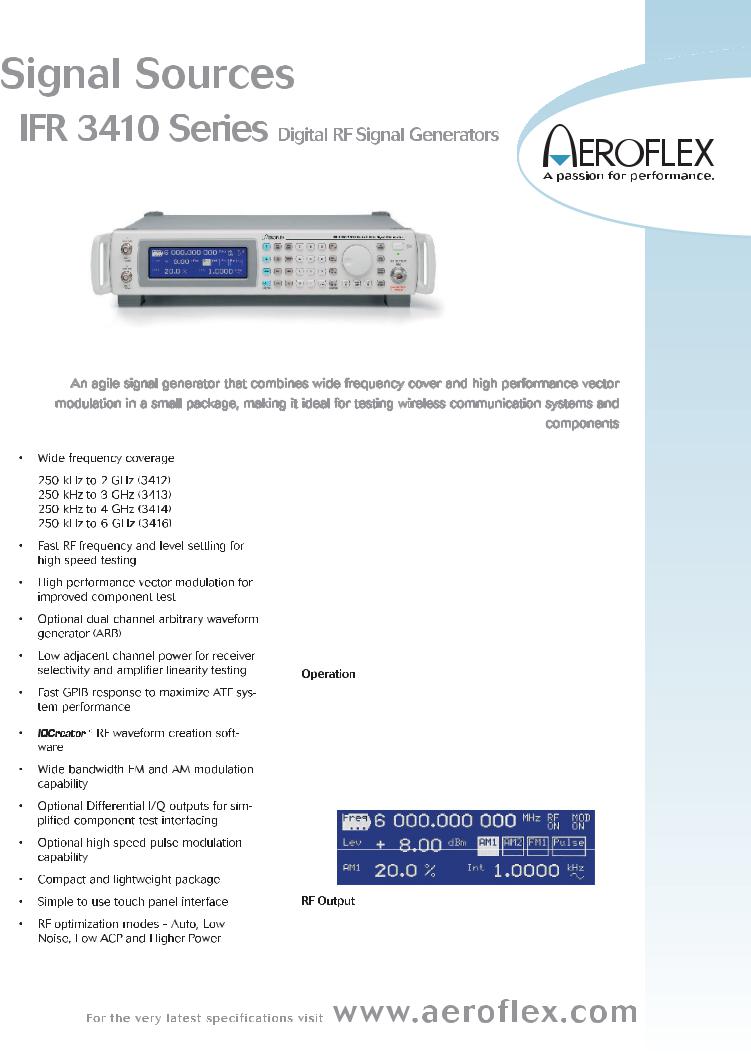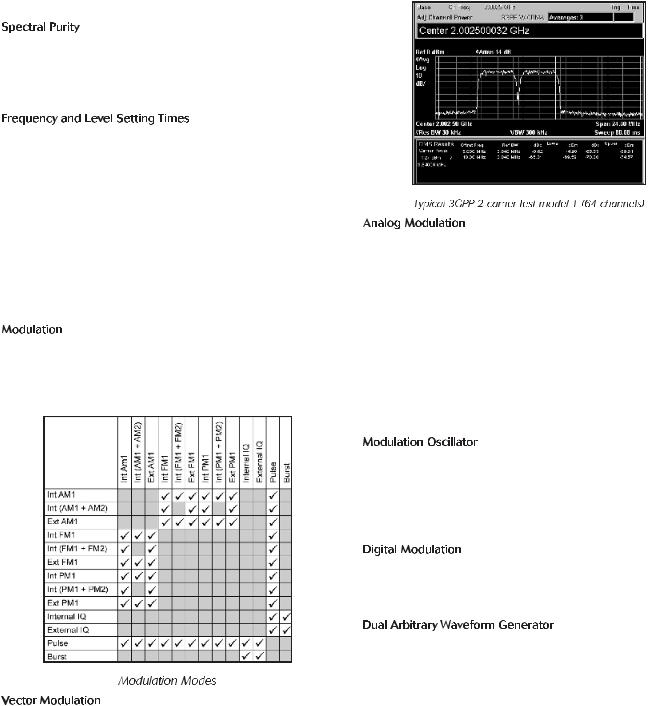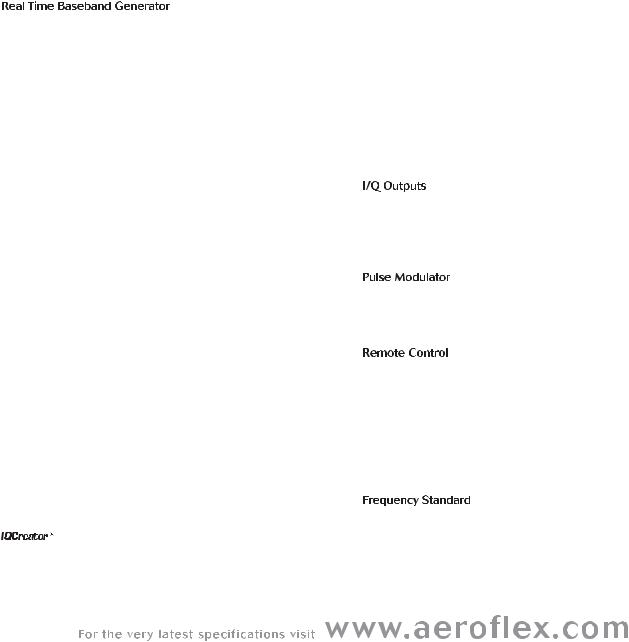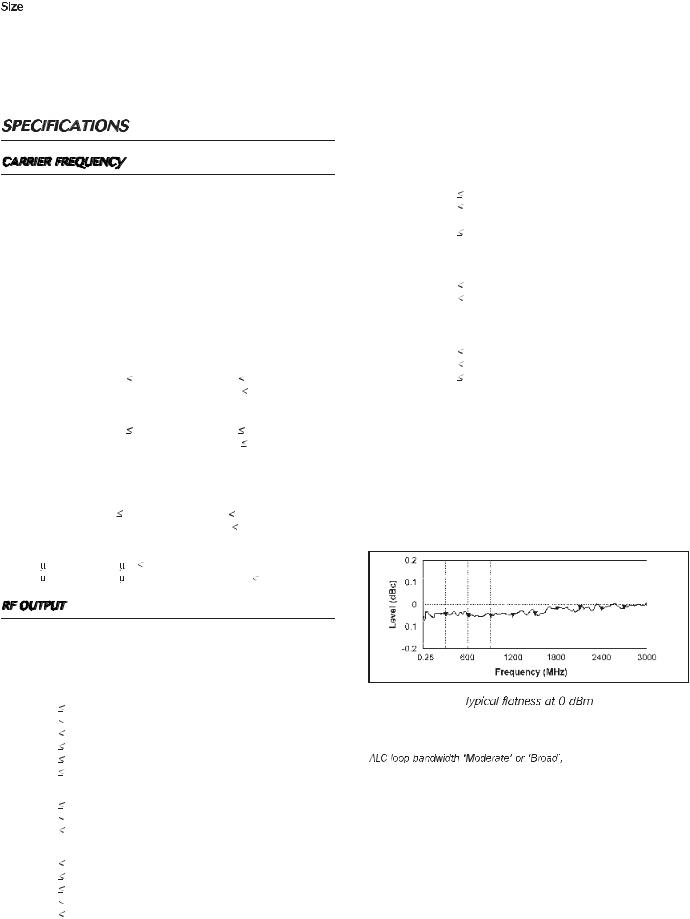Atec Aeroflex-IFR-3416 User Manual

The IFR 3410 series are portable, lightweight signal generators covering a wide range of carrier frequencies to 6 GHz. High quality analog and vector modulation capabilities make these signal generators ideal for research, development and manufacturing applications.
Careful attention to the design of the modulators and the RF system ensures that these signal generators exhibit low levels of adjacent channel power, making them suitable for the most demanding amplifier linearity and receiver selectivity measurements.
T he use of Aeroflex fractional N synthesis techniques, combined with fast level control and an electronic attenuator, ensures the 3410 series signal generators are both frequency and level agile for high speed ATE testing.
A flexible but intuitive user interface based on a touch panel display system ensures that the signal generator meets the needs of unskilled as well as skilled operators. T he instrument can be configured to the required mode of operation very simply, with numerical data being entered by the keyboard or via a rotary control. T he display shows the primary parameters in a clear and unambiguous format, minimizing the risk of operator error.
T he 3410 series signal generators provide peak output power of up to +16 dBm. With a level resolution of 0.01 dB, repeatable and accurate testing of wireless components can be performed.

The electronic attenuator is ideal for high volume applications where attenuator life is critical. A user defined RF level limit can be entered to ensure that the signal generator cannot provide damaging signal levels when testing less robust components. Careful attention to the level control system guarantees that positive level transients cannot be generated. T he fast responding electronic reverse power protection system helps ensure long life and high reliability when testing high power systems.
Receiver measurements require good spectral purity from a signal generator. T he 3410 series has excellent performance with typically 1.5 Hz residual FM at 1 GHz and a floor noise of typically better than -148 dBc / Hz.
Fast frequency and RF level setting times are key parameters in achieving minimum test execution times and therefore maximum throughput, in production environments. T he 3410 series with typical frequency setting times of 2 ms and level setting times of 2.5 ms provide outstanding performance.
In addition to comprehensive sweep functions for carrier frequency, RF level and modulation oscillator 3410 series provides an extremely fast optional sweep mode for frequency and level settings through the use of user stored lists. Option 010, List Mode has a setting time of less than 500 µ s and is ideal for frequency hopping and semi-con- ductor production applications.
Comprehensive modulation facilities are provided for supporting the testing of analog or digital RF systems. A single key press turns the modulation on and off, providing a fast method for signal to noise checking.
T he built-in IQ modulator provides state-of-the-art vector modulated signals with excellent level linearity, low vector error and low noise. With a typical vector bandwidth up to 55 MHz, the modulator is able to support wideband as well as narrow-band wireless standards. Internal calibration systems ensure the modulator performance can
be quickly optimized to reduce vector errors and ensure low carrier leak at all operating frequencies.
The linearity of the modulator and the RF output system is reflected in the excellent adjacent channel power when generating multi-carri- er non-constant envelope signals such as cellular CDMA and TETRA.
With typical AM bandwidth to 30 MHz and typical FM bandwidth to 20 MHz, the 3410 series signal generators are ideal tools for testing broadcast systems. The wide bandwidths allow video signals to modulate the carrier with minimal distortion.
T he wideband FM facilities allow the generation of fast-swept signals, while the use of a patented DC FM system ensures that carrier frequency errors when the FM is DC coupled are minimal.
The specifications for AM are maintained to high carrier frequencies to support the use in modern EMC testing applications. The signal generator maintains excellent phase noise performance even when generating wideband modulated signals.
An internal modulation oscillator is provided which can be used to generate two tones in the frequency range 0.1 Hz to 50 kHz (16 MHz with Option 005 ARB Waveform Generator). In addition to sine waves, the modulation oscillator can provide square waves, triangular and sawtooth waveforms for narrow band sweeping.
T he user has a choice of either a Dual Arbitrary Waveform Generator or a Real Time Baseband Generator for producing digitally modulated output signals.
Fitted internally, the optional Dual Channel Arbitrary Waveform Generator allows the user to select from a library of pre-stored IQ modulator drive waveforms to provide accurately modulated carriers simulating the characteristics of digitally modulated communication systems. Burst modulation and alternate level rf attenuation facilities are provided for TDMA signal simulation. Marker output signals can be placed within the waveform to simplify triggering and synchronization with external test equipment. Using a patented technique, the dual channel ARB is able to take waveform files typically four times oversampled and run them through a real time interpolation

system to raise the sampling rate of the file. This ensures the generation of low adjacent channel power and low spectral noise density. T he dual channel ARB is suited for the generation of both narrow band and wideband signals, including WCDMA signals, without the use of switched reconstruction filters. Combining a large ARB memory with the smaller file size required to define a waveform allows the ARB to store up to 180 waveforms. Alternatively the whole of the memorycan be devoted to a single file. One such file would store over 1.5 seconds of a 3GPP WCDMA waveform signal. T he use of interpolation techniques ensures that when narrow band systems are simulated the waveform generator can still operate at a high sample rate without requiring excessively large amounts of data to be loaded or restricting the repetition time. T he library waveforms are structured in a directory form to ease their selection and the optimization of the user's generator. The modulation waveforms can be simply changed by selection from a file list with the changeover between waveforms occurring in a few milliseconds rather than the many seconds required in more traditional waveform generators. The file name can be determined by the user to convey a useful description of the contents of the file.
Fitted internally, the optional Real Time Baseband, RTBB, generates baseband signals (I and Q) that modulate an RF source in real time to produce generic FSK, PSK and QAM signals at rates up to 2 Msymbols/sec. The RTBB generates or inputs a set of modulation symbols, modulates them with the chosen scheme, filters them using an appropriate channel filter, and then converts the digital stream to analogue I and Q for the I/Q vector modulator. T he source of the symbol data is very flexible. T he symbol data can originate from a variety of internal or external sources. Internal data source choices include a PRBS generator, an internal pattern generator or internal memory storage of user downloaded symbols. External real-time symbol data can be input in serial or parallel format via an industry standard Low Voltage Differential Signalling (LVDS) interface.
Digitized I/Q data, available from sources such as basestation simulators, can be input via the LVDS interface as an alternative to external parallel or serial symbol data. Streaming digitized I/Q data samples are available as an output via the LVDS interface from internally generated symbols for testing D/A convertors.
Synchronized clock, RF Burst, RF Burst Attenuation control and marker output signal facilities are available for both internal and external data generation.
An important feature necessary to support GSM signal generation is the ability to frequency hop between channels. T he RT BB option provides frequency hopping by re-mixing the I and Q data at baseband. T he resultant I and Q vectors then modulate the core synthesizer frequency thus producing a new RF frequency at the output of the signal generator. T his method ensures that synchronization is maintained between the IQ data and the hop trigger. In addition, because the main synthesizer hardware remains unchanged, frequency stabilization is nearly instantaneous.
The 3410 series is supplied with a free copy of 

 , a software package to aid the creation and download of files to the ARB and RTBB options.
, a software package to aid the creation and download of files to the ARB and RTBB options.


 is a Windows based software utility that enables a user to set up a modulation scheme and then create an ARB file using modulation templates. T he resulting file may be saved on a PC or downloaded into the ARB. User-defined configurations can also be saved. Consequently, it is possible to load previously saved setups to regenerate the ARB files quickly and easily. T he capabilities of
is a Windows based software utility that enables a user to set up a modulation scheme and then create an ARB file using modulation templates. T he resulting file may be saved on a PC or downloaded into the ARB. User-defined configurations can also be saved. Consequently, it is possible to load previously saved setups to regenerate the ARB files quickly and easily. T he capabilities of 

 include:-
include:-
Generic Modulation Types
PSK, FSK, MSK, QAM modulation types Nyquist, Root Nyquist and Gaussian filters
PRBS, fixed pattern and user defined data sources
IQ errors - residual carrier, IQ imbalance, quadrature offset Multi-carrier
Also included are 2G, 2.5G and 3G cellular TDMA and CDMA digital standards along with WLAN and other cordless phone standards.
In addition, 

 includes a utility that allows user-defined waveforms, created using software simulation tools such as MAT LAB, to be converted and packaged into a form that can be downloaded into the 3410 Series ARB.
includes a utility that allows user-defined waveforms, created using software simulation tools such as MAT LAB, to be converted and packaged into a form that can be downloaded into the 3410 Series ARB.


 is continually updated to include new modulation capabilities and facilities. T he latest version is available for download at www.aeroflex.com.
is continually updated to include new modulation capabilities and facilities. T he latest version is available for download at www.aeroflex.com.
Options to have an instrument's ARB pre-loaded with a suite of example waveform files are available. A selection of waveforms from each of the standards, or just waveforms relevant to the user's applications, can be chosen. Although only available at the time of order, all the waveforms are available within IQCreator should any of the files be deleted then required in the future.
Single ended baseband I/Q outputs are available as standard. Differential I/Q outputs, combined with comprehensive voltage bias and offset facilities, are optionally available to simplify component and module testing.
An optional pulse modulator allows the generation of fast rise time RF signals with on/off ratios that meet the most demanding radar and ECM/ECCM test applications.
The 3410 series include both fast GPIB and Ethernet remote control interfaces for flexibility in production environments. RS-232 control is also provided for use in legacy AT E systems.
The protocol and syntax of the GPIB commands have been designed in accordance with IEEE 488.2 to simplify program generation. Plug and play drivers are available that include a virtual front panel for remote instrument supervision and debug.
T he 3410 series includes a high stability OCXO as standard. T he inclusion of a main input power standby mode maintains the oscillator at working temperature while the rest of the instrument is powered down. Time to full specification working is thereby minimized for equipment facilities held on standby.

T he 2U rack height ensures the 3410 series occupies minimal space in a manufacturing rack or on the engineer's bench, allowing the provision of more compact test systems. T he full rack width ensures easy stacking of instruments while the light weight allows for easy carrying in the laboratory or the field.
Range
250 kHz - 2 GHz (3412)
250 kHz - 3 GHz (3413)
250 kHz - 4 GHz (3414)
250 kHz - 6 GHz (3416)
Resolution
1 Hz, accuracy as frequency standard
The carrier output phase can be advanced or retarded in increments of 0.036°.
FREQUENCY SETTING TIME (NON-LIST MODE)
After receipt of the GPIB interface deliminator (terminator), 23°C ± |
5°C |
|||
Phase Noise Mode Optimized > 10 kHz |
|
|
||
< 5.5 ms, typically 4 ms, |
375 MHz, to be within |
200 Hz |
||
|
|
> 375 MHz, to be within |
0.1 ppm |
|
Phase Noise Mode Optimized < 10 kHz |
|
|
||
< 3 ms, typically 2.5 ms, |
375 MHz, to be within |
200 Hz |
||
< 2.5 ms, typically 2 ms, > 375 MHz, to be within |
0.1 ppm |
|||
FREQUENCY SETTING TIME (OPTION 010 LIST MODE) |
||||
After external trigger in List Mode, 23°C ± 5°C |
|
|
||
Phase Noise Mode Optimized > 10 kHz |
|
|
||
< 4 ms, typically 3 ms, |
375 MHz, to be within |
200 Hz |
||
|
> 375 MHz, to be within |
0.1 ppm |
||
Phase Noise Mode Optimized < 10 kHz |
|
|
||
<600 |
s, typically 500 |
s, 375 MHz, to be within < 200 Hz |
||
<500 |
s, typically 450 |
s, > 375 MHz, to be within 0.1 ppm |
||
The RF output is controlled by an ALC system in normal operation. When IQ modulation is enabled alternative control modes are available to optimize the performance of the signal generator.
Range |
|
Electronic Attenuator |
|
10 MHz |
-140 to + 13 dBm |
2 GHz |
-140 to + 16 dBm |
3 GHz |
-140 to + 16 dBm |
3.75 GHz |
-140 to + 13 dBm |
4 GHz |
-140 to + 10 dBm |
6 GHz |
-140 to + 8 dBm |
Mechanical Attenuator |
|
10 MHz |
-140 to + 16 dBm |
2 GHz |
-140 to + 19 dBm |
3 GHz |
-140 to + 16 dBm |
No Attenuator |
|
10 MHz |
0 to + 21 dBm |
3 GHz |
0 to + 22 dBm |
3.75 GHz |
0 to + 20 dBm |
4 GHz |
0 to + 17 dBm |
6 GHz |
0 to + 18 dBm |
When AM is selected the maximum RF output is linearly reduced by up to 6 dB depending on the requested AM depth.
When IQ modulation is selected maximum output is reduced by 6 dB below 100 MHz.
Resolution
0.01 dB
RF Level Units
Units can be set to µ V, mV, V EMF or PD; dB relative 1 µ V, 1 mV, 1 V EMF or PD; or dBm. Conversion between dB and linear units may be achieved by pressing the appropriate units key (dB or V, mV or µ V).
RF Output Accuracy (@ 23°C ± |
5°C) |
|
||
Electronic Attenuator |
|
|
|
|
RF Mode |
|
|
-127 to -30 dBm |
> -30 dBm |
Auto |
2 GHz |
± 0.75 dB |
± 0.50 dB |
|
|
3 GHz |
± 1.00 dB |
± 0.75 dB |
|
|
|
|
-110 to -30 dBm |
> -30 dBm |
|
6 GHz |
± 1.25 dB |
± 1.00 dB |
|
Mechanical Attenuator |
|
|
||
RF Mode |
|
|
-127 to -28 dBm |
> -28 dBm |
Auto |
2 GHz |
± 0.75 dB |
± 0.50 dB |
|
|
3 GHz |
± 1.00 dB |
± 0.75 dB |
|
No Attenuator |
|
|
|
|
RF Mode |
|
|
> 0 dBm |
|
Auto |
2 |
GHz |
± 0.50 dB |
|
|
3 |
GHz |
± 0.75 dB |
|
|
6 |
GHz |
± 1.00 dB |
|
Level Accuracy With IQ Modulation
For constant envelope modulation systems: typical standard level error
± 0.15 dB
For non-constant envelope modulation systems: typical standard level error ± 0.25 dB
Temperature Stability
±0.01 dB/°C,  3 GHz
3 GHz
±0.02 dB/°C,  4 GHz, ± 0.02 dB/°C typical,
4 GHz, ± 0.02 dB/°C typical,  6 GHz
6 GHz
RF Flatness
LEVEL SETTING TIME
Electronic attenuator, Option 003 is assumed in all cases.





 0.3 dB
0.3 dB
Level Setting Time (Non-List Mode)
After receipt of the GPIB interface deliminator (terminator), 23°C ± 5°C < 4.5 ms, typically 2.5 ms
Level Setting Time (Option 010 List Mode)
After external trigger in List Mode, 23°C ± 5°C < 3 ms, typically 1.5 ms
